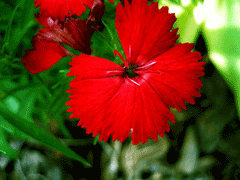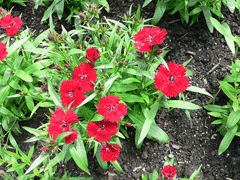 |
|
http://commons.wikimedia.org/wiki/User:Midimacman |
 |
| http://commons.wikimedia.org/wiki/User:Raulbot |
Translate this page:
Summary
Bloom Color: Pink.
Main Bloom Time: Early summer, Early fall, Late summer, Mid summer. Form: Rounded.
Physical Characteristics

 Dianthus chinensis is a PERENNIAL growing to 0.7 m (2ft 4in) at a medium rate.
Dianthus chinensis is a PERENNIAL growing to 0.7 m (2ft 4in) at a medium rate.
See above for USDA hardiness. It is hardy to UK zone 7. It is in flower from July to August, and the seeds ripen from August to September. The species is hermaphrodite (has both male and female organs) and is pollinated by Bees, Lepidoptera (Moths & Butterflies).
It is noted for attracting wildlife.
Suitable for: light (sandy), medium (loamy) and heavy (clay) soils and prefers well-drained soil. Suitable pH: mildly acid, neutral and basic (mildly alkaline) soils. It cannot grow in the shade. It prefers dry or moist soil.
UK Hardiness Map
US Hardiness Map
Synonyms
Plant Habitats
Cultivated Beds;
Edible Uses
References More on Edible Uses
Medicinal Uses
Plants For A Future can not take any responsibility for any adverse effects from the use of plants. Always seek advice from a professional before using a plant medicinally.
Anthelmintic Antibacterial Antiphlogistic Diaphoretic Diuretic Emmenagogue Febrifuge Haemostatic
Ophthalmic Tonic Urinary
The Chinese pink has been used for over 2,000 years in Chinese herbal medicine[238]. The whole plant is a bitter tonic herb that stimulates the digestive and urinary systems and also the bowels[238]. It is also anthelmintic, antibacterial, antiphlogistic, diaphoretic, diuretic, emmenagogue, febrifuge and haemostatic[218, 238, 279]. It is used internally in the treatment of acute urinary tract infections (especially cystitis), urinary stones, constipation and failure to menstruate[238]. It is used externally to treat skin inflammations and swellings[238]. The old leaves are crushed and used for clearing the eyesight[218]. The plants are harvested just before the flowers open and are dried for later use[238].
References More on Medicinal Uses
The Bookshop: Edible Plant Books
Our Latest books on Perennial Plants For Food Forests and Permaculture Gardens in paperback or digital formats.

Edible Tropical Plants
Food Forest Plants for Hotter Conditions: 250+ Plants For Tropical Food Forests & Permaculture Gardens.
More

Edible Temperate Plants
Plants for Your Food Forest: 500 Plants for Temperate Food Forests & Permaculture Gardens.
More

More Books
PFAF have eight books available in paperback and digital formats. Browse the shop for more information.
Shop Now
Other Uses
References More on Other Uses
Cultivation details
Landscape Uses:Border, Container, Ground cover, Massing, Rock garden. Prefers a rich well-drained loamy neutral to alkaline soil in a sunny position[1, 238], but succeeds in most soils including dry ones[1]. A very ornamental plant[1], it is usually biennial in habit, but can be a short-lived perennial. There are many cultivars that are widely grown in gardens. Since these flower freely in their first year and then degenerate, they are usually treated as annuals[200]. A very variable species in the wild, it has often been subdivided into up to eight different varieties[266]. Special Features:Attractive foliage, Naturalizing, Suitable for cut flowers, Fragrant flowers, Attractive flowers or blooms.
References Carbon Farming Information and Carbon Sequestration Information
Temperature Converter
Type a value in the Celsius field to convert the value to Fahrenheit:
Fahrenheit:
The PFAF Bookshop
Plants For A Future have a number of books available in paperback and digital form. Book titles include Edible Plants, Edible Perennials, Edible Trees,Edible Shrubs, Woodland Gardening, and Temperate Food Forest Plants. Our new book is Food Forest Plants For Hotter Conditions (Tropical and Sub-Tropical).
Shop Now
Plant Propagation
Seed - sow May/June in a cold frame. The seed usually germinates in 2 - 3 weeks. When they are large enough to handle, prick the seedlings out into individual pots and plant them out in the summer or autumn[1]. The seed can also be sown thinly in an outdoor seedbed in late spring, the young plants being planted out in late spring or the autumn1]. Cuttings of half-ripe shoots, July in a frame[1]. Division in September[1]. Larger clumps can be replanted direct into their permanent positions, though it is best to pot up smaller clumps and grow them on in a cold frame until they are rooting well. Plant them out in the spring.
Other Names
If available other names are mentioned here
Native Range
TEMPERATE ASIA: China (Gansu Sheng, Hebei Sheng, Heilongjiang Sheng, Henan Sheng, Jilin Sheng, Liaoning Sheng, Nei Mongol Zizhiqu, Ningxia Huizi Zizhiqu, Qinghai Sheng, Shaanxi Sheng, Shandong Sheng, Shanxi Sheng, Xinjiang Uygur Zizhiqu), Korea TROPICAL ASIA: India (Jammu and Kashmir, Tripura, Uttar Pradesh), Nepal
Weed Potential
Right plant wrong place. We are currently updating this section.
Please note that a plant may be invasive in one area but may not in your area so it's worth checking.
Conservation Status
IUCN Red List of Threatened Plants Status :

Growth: S = slow M = medium F = fast. Soil: L = light (sandy) M = medium H = heavy (clay). pH: A = acid N = neutral B = basic (alkaline). Shade: F = full shade S = semi-shade N = no shade. Moisture: D = dry M = Moist We = wet Wa = water.
Now available:
Food Forest Plants for Mediterranean Conditions
350+ Perennial Plants For Mediterranean and Drier Food Forests and Permaculture Gardens.
[Paperback and eBook]
This is the third in Plants For A Future's series of plant guides for food forests tailored to
specific climate zones. Following volumes on temperate and tropical ecosystems, this book focuses
on species suited to Mediterranean conditions—regions with hot, dry summers and cool, wet winters,
often facing the added challenge of climate change.
Read More
Expert comment
Author
L.
Botanical References
200266
Links / References
For a list of references used on this page please go here
Readers comment
| Add a comment |
|
If you have important information about this plant that may help other users please add a comment or link below. Only comments or links that are felt to be directly relevant to a plant will be included. If you think a comment/link or information contained on this page is inaccurate or misleading we would welcome your feedback at [email protected]. If you have questions about a plant please use the Forum on this website as we do not have the resources to answer questions ourselves.
* Please note: the comments by website users are not necessarily those held by PFAF and may give misleading or inaccurate information.
To leave a comment please Register or login here All comments need to be approved so will not appear immediately.
|
Subject : Dianthus chinensis
|
|
|
|